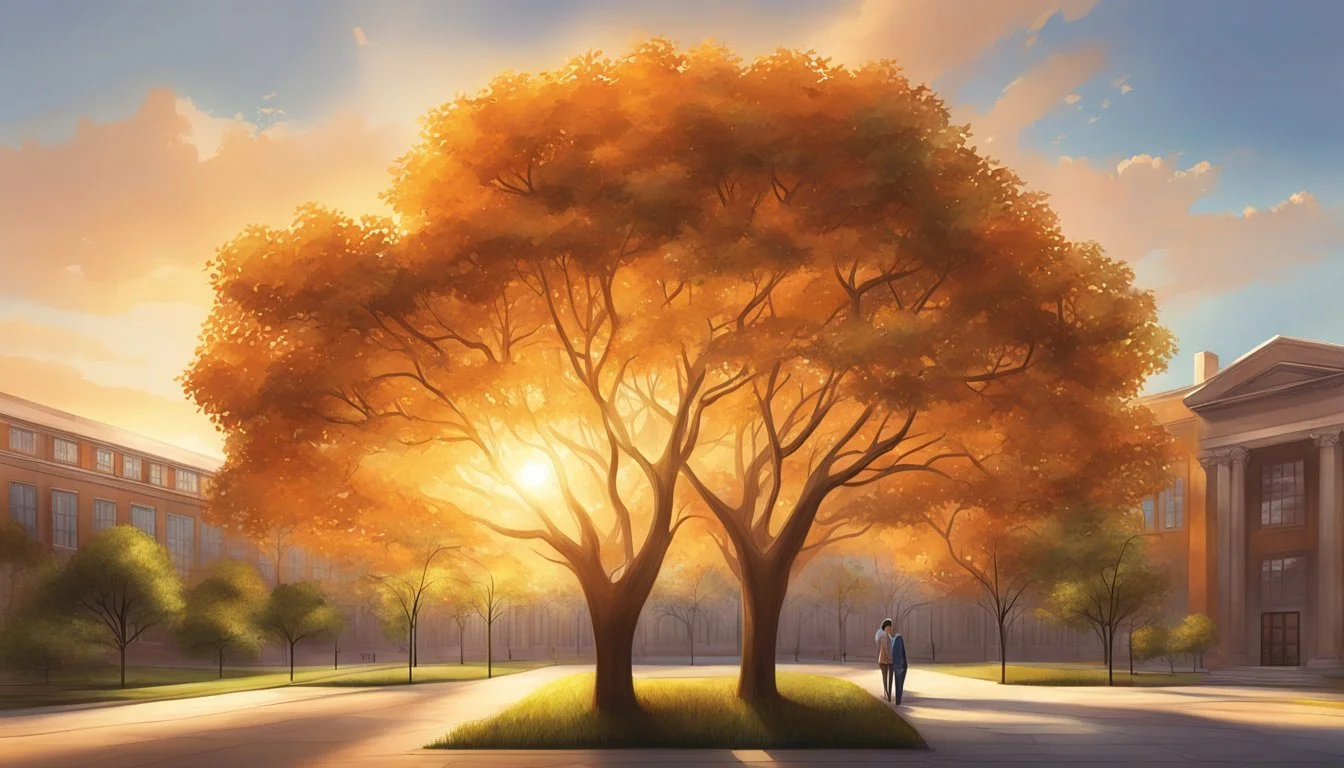The Orange Tree: Campus Crime Podcast Branches Out to Visual Media
New Documentary Series Launches
"The Orange Tree" podcast captivated audiences with its compelling exploration of a tragic campus crime. Created by University of Texas at Austin journalism students Haley Butler and Tinu Thomas, the series delved into the 2005 murder of Jennifer Cave at the Orange Tree Condos near campus.
The success of "The Orange Tree" has led to its expansion into visual media, broadening its reach and impact. This move allows the storytellers to present the case through a new lens, potentially uncovering fresh perspectives on the events that shook the UT Austin community.
The transition to visual formats demonstrates the versatility of true crime narratives and the evolving landscape of multimedia journalism. As "The Orange Tree" branches out, it continues to engage audiences while maintaining its commitment to sensitive reporting and thoughtful examination of a complex case.
Origins of 'The Orange Tree'
'The Orange Tree' podcast emerged from a campus tragedy, growing into a compelling exploration of a shocking crime. Two University of Texas journalism students transformed their investigative reporting into a gripping audio series that captivated listeners.
Conception and Development
Haley Butler and Tinu Thomas, UT Austin journalism students, began work on 'The Orange Tree' in January 2019. The podcast focuses on the 2005 murder of 21-year-old Jennifer Cave at the Orange Tree Condos near campus. Butler and Thomas spent over a year researching, conducting interviews, and crafting the narrative.
The pair aimed to tell Cave's story with sensitivity, moving beyond sensationalism common in true crime. They delved into court records, spoke with those connected to the case, and examined the impact on multiple families.
Meaning Behind the Name
'The Orange Tree' takes its name from the Orange Tree Condominiums where the crime occurred. This location, in Austin's West Campus area, became central to the story. The name ties the podcast directly to the physical setting of the events.
The title also serves as a stark contrast - the pleasant imagery of an orange tree against the brutal reality of the crime. This juxtaposition reflects the podcast's approach of examining the complex human elements behind a shocking headline.
The Drag Audio Production House
'The Orange Tree' was produced under The Drag, an audio production house affiliated with UT Austin's Moody College of Communication. The Drag provides students with hands-on experience in podcasting and audio storytelling.
Led by experienced faculty, The Drag offers resources and guidance to student creators. This support was crucial in helping Butler and Thomas develop their initial idea into a polished, professional podcast series.
The success of 'The Orange Tree' has solidified The Drag's reputation as an incubator for high-quality audio journalism. It showcases the potential of student-led projects when given proper support and resources.
Key Individuals
The Orange Tree podcast centers around several important figures who shaped the narrative of this compelling true crime story. From the creators behind the project to those directly involved in the case, each played a crucial role.
Hosts and Creators
Haley Butler and Tinu Thomas developed The Orange Tree podcast while studying journalism at the University of Texas. The duo began working on the project in January 2019 during their senior year. Butler and Thomas spent over a year researching, interviewing sources, and crafting the seven-episode series.
Their approach focused on sensitive storytelling and in-depth reporting. They aimed to provide a nuanced perspective on the case, avoiding sensationalism common in true crime media. The hosts' dedication to thorough journalism and empathetic storytelling resonated with listeners, propelling the podcast to widespread acclaim.
The Life of Jennifer Cave
Jennifer Cave was a vibrant 21-year-old at the center of this tragic story. She had recently started a new job and was celebrating in Austin when she disappeared. Jennifer's life was cut short in August 2005 at the Orange Tree Condominiums near the University of Texas campus.
Friends and family described Jennifer as kind-hearted and full of potential. Her mother, Sharon Cave, became a vocal advocate for justice following her daughter's death. Jennifer's story and the impact of her loss form the emotional core of the podcast.
Profiles of the Convicted
Two University of Texas students were convicted in connection with Jennifer Cave's death. Colton Pitonyak, a finance major, was found guilty of murder and sentenced to 55 years in prison. Laura Hall, Pitonyak's friend, was convicted of tampering with evidence and hindering apprehension.
The podcast explores their backgrounds, relationships, and the events leading up to the crime. It delves into the shocking nature of the case, which involved two seemingly successful college students. Their convictions sent shockwaves through the university community and beyond.
The Infamous Crime
The 2005 murder of Jennifer Cave at the Orange Tree Condos in Austin shocked the community and led to a high-profile criminal case. The brutal nature of the crime and the involvement of University of Texas students drew widespread attention.
Overview of the Case
On August 17, 2005, Jennifer Cave's body was discovered in a West Campus apartment. The 21-year-old had been shot and dismembered. Colton Pitonyak, a UT student, was quickly identified as a suspect.
Laura Hall, another UT student, was also implicated in the crime. The pair fled to Mexico but were apprehended and brought back to face charges.
The Austin Police Department conducted a thorough investigation, collecting evidence from the crime scene at the Orange Tree Condos.
Court Trials and Verdicts
Pitonyak's trial began in 2007. Prosecutors presented forensic evidence and witness testimony linking him to Cave's murder. After deliberation, the jury found Pitonyak guilty of first-degree murder.
He received a 55-year sentence in the Texas Department of Criminal Justice system.
Hall faced separate charges for her role in the crime. She was convicted of tampering with evidence and hindering apprehension. Her initial 5-year sentence was later increased to 10 years on appeal.
Court documents revealed gruesome details of the crime, shocking many who followed the case.
Impact on the Community
The murder sent shockwaves through Austin, particularly among UT students. Many felt unsafe in the West Campus area where the crime occurred.
The case prompted discussions about campus safety and led to increased security measures around student housing complexes.
Local media coverage was extensive, keeping the community informed throughout the investigation and trials.
The Orange Tree Condos became infamous, with many residents moving out in the aftermath of the crime.
Years later, the case continues to resonate with Austinites, serving as a stark reminder of how violence can impact a community.
Podcast Structure
The Orange Tree podcast employs a carefully crafted structure to deliver its true crime narrative. It combines episodic storytelling, in-depth reporting, and compelling interviews to provide a comprehensive exploration of the case.
Season and Episodes Breakdown
Season 1 of The Orange Tree consists of seven episodes. Each episode runs approximately 30-40 minutes, allowing for thorough coverage of different aspects of the case. The series begins with an overview of the crime and gradually delves into the investigation, suspects, and trial proceedings.
Episode 1 sets the stage by introducing the victim and the crime scene. Subsequent episodes focus on specific elements such as the suspects' backgrounds, forensic evidence, and witness testimonies. The finale ties together the various threads and explores the aftermath of the trial.
Narrative and Storytelling
The podcast employs a chronological narrative structure, guiding listeners through the events leading up to the crime, the investigation, and its aftermath. The hosts use a mix of narration, archival audio, and interview segments to create a compelling storyline.
Key storytelling techniques include:
Cliffhangers at episode endings
Flashbacks to provide context
Character development of key figures
These elements help maintain listener engagement throughout the series.
Interviews and Reporting
Extensive interviews form the backbone of The Orange Tree's reporting. The hosts conducted over 30 interviews with individuals connected to the case, including:
Law enforcement officers
Family members of the victim and suspects
Eyewitnesses
Legal experts
These firsthand accounts provide unique insights and emotional depth to the narrative. The hosts also incorporate court documents, police records, and media reports to ensure factual accuracy and comprehensive coverage of the case.
Transition to Visual Media
The Orange Tree podcast expanded beyond audio, adapting its true crime storytelling to visual formats. This move brought new challenges and opportunities for the creators while reaching broader audiences.
From Audio to Documentary
The transition from podcast to documentary allowed The Orange Tree to visually explore the crime scene and locations relevant to the case. Interviews with key figures gained added impact through on-camera appearances. The documentary format enabled the inclusion of archival footage and photographs, providing viewers with a more immersive experience.
Visual elements helped convey the emotional weight of the story in ways audio alone could not. The documentary retained the podcast's sensitivity toward victims and families while leveraging visual storytelling techniques.
Challenges and Achievements
Adapting audio content to visual media presented technical and creative hurdles. The production team had to learn new skills in cinematography, editing, and visual storytelling. Balancing the pacing of the narrative across different mediums proved challenging.
Despite these obstacles, the team achieved a cohesive visual adaptation that complemented the original podcast. The documentary maintained the intimate tone of the audio series while adding compelling visual elements.
A key achievement was translating the podcast's nuanced approach to true crime into a visual format without sensationalizing the subject matter.
Reception and Critiques
Viewers praised the documentary's thoughtful treatment of the case and its visual storytelling. Many appreciated the added context provided by seeing locations and individuals featured in the podcast. The visual adaptation attracted new audiences to The Orange Tree story.
Some critics felt the documentary lacked the intimacy of the podcast format. Others noted that certain audio elements didn't translate as effectively to screen. However, most reviewers commended the production team's efforts to maintain sensitivity while expanding to a new medium.
The documentary's reception reinforced The Orange Tree's reputation for responsible true crime storytelling across multiple platforms.
Cultural and Societal Commentary
True crime podcasts have become a cultural phenomenon, sparking debates about media ethics and societal impact. "The Orange Tree" stands out for its approach to storytelling and treatment of sensitive subject matter.
The Role of True Crime in Media
True crime content has exploded in popularity across various platforms. Podcasts like "The Orange Tree" have tapped into the public's fascination with real-life mysteries and criminal cases. These stories often provide a window into complex social issues and human psychology.
True crime media can raise awareness about unsolved cases and flaws in the justice system. It also satisfies a widespread curiosity about the darker aspects of human nature. "The Orange Tree" exemplifies how journalists can craft compelling narratives while maintaining respect for victims and their families.
Ethical Considerations
Creators of true crime content face significant ethical challenges. Balancing storytelling with sensitivity towards victims and their loved ones is crucial. "The Orange Tree" podcast demonstrates a commitment to this delicate balance.
The series focuses on providing support to affected families and giving voice to victims. This approach sets a standard for responsible true crime journalism. It highlights the importance of thorough research and respectful reporting practices.
Ethical considerations extend to the potential impact on audiences. Producers must weigh the educational value against the risk of sensationalism or trauma. "The Orange Tree" strives to inform and engage listeners without exploiting the tragedy at its core.
Engagement and Community Response
"The Orange Tree" podcast garnered significant listener engagement and sparked community discussions. Social media platforms played a key role in facilitating interactions between the creators and audience.
Listener Interaction
The podcast's presence on platforms like Twitter and Instagram allowed fans to connect directly with hosts Haley Butler and Tinu Thomas. Listeners shared their thoughts, theories, and questions about the case through comments and direct messages.
The creators actively responded to audience inquiries, fostering a sense of community around the show. This two-way communication helped maintain interest and encouraged listeners to tune in for each new episode.
Many fans expressed appreciation for the podcast's sensitive approach to true crime storytelling. The focus on Jennifer Cave's life, rather than just the details of her death, resonated with listeners seeking more respectful true crime content.
Updates and Follow-up
As the podcast gained popularity, Butler and Thomas provided regular updates to their audience. They shared behind-the-scenes information about the production process and insights into their research methods.
The hosts used Apple Podcasts and Spotify to release bonus content, including extended interviews and additional case details. These extras helped maintain listener engagement between full episodes.
Social media platforms served as a hub for sharing new developments in the case. When relevant updates occurred, the creators promptly informed their audience through posts and stories.
The podcast's success led to increased support from the University of Texas community. This backing enabled the creators to explore potential visual adaptations of "The Orange Tree" story, expanding its reach beyond the audio format.
Behind the Scenes
The production of "The Orange Tree" podcast involved meticulous audio work and a dedicated creative team. Their efforts brought the true crime story to life through sound.
Recording and Production Insights
The podcast's audio quality was paramount. Producers utilized professional-grade microphones and soundproofed recording spaces to capture clear narration and interviews. Sound engineers expertly mixed ambient sounds and music to enhance the storytelling.
Post-production involved careful editing to create a cohesive narrative flow. The team spent hours selecting the most impactful clips from interviews and archival footage. They layered in sound effects to recreate key moments, immersing listeners in the story's atmosphere.
Fact-checking was rigorous. Producers cross-referenced multiple sources to ensure accuracy in every detail presented. This attention to detail lent credibility to the podcast's reporting.
The Creative Team
Tinu Thomas and Haley Butler led the project as co-directors and hosts. Their investigative journalism backgrounds proved crucial in uncovering new insights into the case.
The Drag, a production house affiliated with the University of Texas at Austin, provided support and resources. Their expertise in audio storytelling helped shape the podcast's structure and pacing.
A team of researchers assisted in combing through court documents, news archives, and conducting additional interviews. Their work formed the foundation of the narrative.
Audio engineers and editors worked tirelessly to craft the final product. Their technical skills ensured a polished, professional sound that rivaled major network productions.
Further Reading and Resources
The Orange Tree podcast offers additional materials and various listening options for those interested in exploring the case further. Audiences can access supplementary content and tune in across multiple platforms.
Additional Materials
The Orange Tree website provides transcripts of each episode for readers who prefer text. Listeners can find photos, court documents, and news articles related to the Jennifer Cave murder case. The podcast creators compiled a timeline of key events to help audiences follow the complex story.
KUT, Austin's NPR station, features interviews with the podcast hosts discussing their reporting process. These behind-the-scenes insights shed light on the challenges of covering sensitive true crime stories. Wondery's true crime podcast network offers similar cases for listeners wanting to explore related content.
Where to Listen and Watch
The Orange Tree is available on major podcast platforms including Apple Podcasts and Spotify. Listeners can stream episodes for free or download them for offline listening. The show's website hosts all episodes with accompanying visuals.
Video content related to The Orange Tree can be found on YouTube, featuring interviews and location footage. Social media accounts on Instagram and Twitter share updates and additional case information. For visual learners, the podcast team created an interactive map of key locations mentioned in the series.









